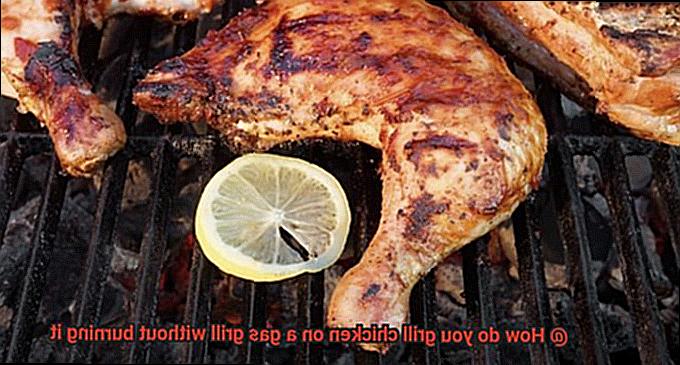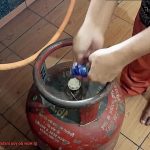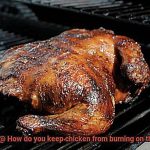Are you tired of serving up dry and burnt chicken that’s more reminiscent of a piece of charcoal than a delicious meal? Grilling chicken on a gas grill can be tricky, but fear not. With a few easy tips and tricks, you’ll be able to achieve perfectly succulent and flavorful chicken every time.
First things first: choosing the right cut of chicken is crucial. Opt for bone-in and skin-on chicken thighs or drumsticks, as they retain moisture better than skinless, boneless breasts. And when it comes to heat, don’t crank it up too high. Overcooking the chicken on high heat will only lead to burnt meat. Instead, use medium heat and cook for around 10-12 minutes per side without constantly flipping it.
But wait, there’s more. Preheating your gas grill is essential for even cooking and avoiding burnt spots. And if you’re feeling adventurous, try marinating your chicken beforehand for an extra boost of flavor.
In this blog post, we’ll delve into these tips in greater detail (and share a few more) to help you become a grilling pro. So grab your apron and fire up that gas grill – it’s time to impress your guests with perfectly grilled chicken without any burnt mishaps.
Contents
Preheating the Grill
As a grilling expert, I can confidently say that preheating your gas grill is absolutely crucial when it comes to cooking chicken. Not only does it ensure that your meat cooks evenly, but it also prevents sticking and gives your chicken those beautiful grill marks that we all love. In this post, we’ll explore why preheating is important, how to do it right, and some tips for grilling chicken on a preheated grill.
Why Preheat Your Grill?
Preheating your grill serves several purposes. Firstly, it allows the grill grates to get hot, which is essential for searing the meat and preventing it from sticking. Secondly, it ensures that the internal temperature of the grill is consistent, leading to even cooking. And lastly, preheating helps to burn off any leftover debris from previous grilling sessions, ensuring a clean cooking surface.
How to Preheat Your Grill
To preheat your gas grill properly, start by turning on all the burners to high heat and closing the lid. Let the grill heat up for at least 10-15 minutes or until it reaches a temperature of around 400-450°F. This time allows the grates to get hot and any leftover debris to burn off entirely.
It’s important to note that different types of grills may require different preheating times. For example, thicker grills may take longer than thinner ones. Weather conditions can also affect preheating times, so adjust accordingly.
Once your grill is adequately preheated, use a wire brush or scraper to clean off any residue from the grates. This will ensure that your chicken doesn’t stick and will also give it those beautiful sear marks that we all love.
Tips for Grilling Chicken on a Preheated Grill
Now that you have a preheated grill, it’s time to start grilling. Here are some tips for grilling chicken on a preheated grill:
- Season your chicken properly before grilling. This not only adds flavor but also helps keep the meat moist and tender.
- Place the chicken on the grill with the skin-side up first. This helps protect the meat from direct heat and prevents it from burning.
Seasoning the Chicken
Seasoning the chicken is a crucial step in grilling it on a gas grill without burning it. Not only does proper seasoning enhance the flavor of the chicken, but it also helps to keep it moist and tender. Before grilling, marinating the chicken for at least 30 minutes is essential to allow the seasoning to penetrate the meat.
When it comes to seasoning, there are endless options available. From traditional BBQ rubs and marinades to more exotic flavors like lemon and herb or jerk seasoning, the possibilities are endless. Even a simple combination of salt, pepper, and olive oil can be enough to transform your chicken into a mouth-watering dish.
To ensure even seasoning, pat dry the chicken before applying any marinade or seasoning. This removes excess water from the chicken, allowing the marinade to stick better. Use a brush or your hands to coat the chicken evenly with your chosen seasoning.
After applying the seasoning, let the chicken rest for a few minutes. This allows the flavors to meld together, ensuring that every bite is properly seasoned. Over-seasoning your chicken can lead to burning on the grill, so use caution when adding your chosen spices.
Placing the Chicken on the Grill
Indulging in succulent and juicy grilled chicken is always a delight. But, placing the chicken on the grill can be a tricky task. As an expert on grilling, I’m here to share with you some tips and tricks to make sure your chicken is cooked to perfection without burning.
First things first, let’s talk about grill preparation. Cleaning and oiling the grates before placing your chicken on the grill is crucial to prevent sticking. Don’t forget to preheat the grill for at least 10-15 minutes to ensure even cooking.
Now, let’s dive into the main event: placing the chicken on the grill. Arranging your chicken in a single layer with enough space in between is essential to avoid overcrowding. Overcrowding can lead to flare-ups and uneven cooking, resulting in burnt or undercooked chicken – which is not what we want.
To create a crispy texture and seal in the juices, start grilling your chicken with the skin side down. Not only will this result in a flavorful and moist chicken, but it will also make your taste buds sing. Furthermore, resist flipping the chicken repeatedly as it can cause sticking and tearing.
Using a meat thermometer is vital to ensure even cooking. Checking the internal temperature of the chicken with a meat thermometer helps you achieve perfectly grilled chicken. The ideal temperature for cooked chicken is 165°F (74°C). Once you’ve reached this temperature, remove the chicken from the grill and let it rest for a few minutes before serving.
Monitoring the Temperature of the Grill
Well, before you start, let’s talk about the importance of monitoring the temperature of your grill. This is the key to avoiding a burnt and dry chicken disaster.
First things first, don’t forget to clean your grill and preheat it properly. Preheating the grill ensures that your chicken cooks evenly and doesn’t stick to the grates. Once your grill is preheated, it’s time to monitor the temperature.
Maintaining a consistent temperature between 350°F – 450°F is crucial for grilling chicken. If the temperature is too low, your chicken will cook slowly and may dry out. If the temperature is too high, it can burn the outside of the chicken while leaving the inside raw. So keep an eye on that temperature gauge.
But wait, there’s more. Using a meat thermometer is also highly recommended for monitoring the internal temperature of your chicken. The USDA recommends cooking chicken to an internal temperature of 165°F. Simply insert the thermometer into the thickest part of the chicken without touching any bones and wait for an accurate reading.
Feeling like a pro yet? Here’s another tip – use your hand as a guide for heat levels. Hold your hand about 6 inches above the grill grates and count how long you can keep it there comfortably. If you can hold it for 4-5 seconds, then your heat is medium-high (375°F – 450°F). If you can only hold it for 2-3 seconds, then it’s high (450°F – 550°F). If you can hold it for more than 5 seconds, then it’s low (250°F – 350°F).
In summary, here are some important steps to follow when monitoring the temperature of your gas grill while grilling chicken:
- Clean and preheat your grill properly
- Maintain a consistent temperature between 350°F – 450°F
- Use a meat thermometer to check the internal temperature of your chicken
- Use your hand as a guide for heat levels
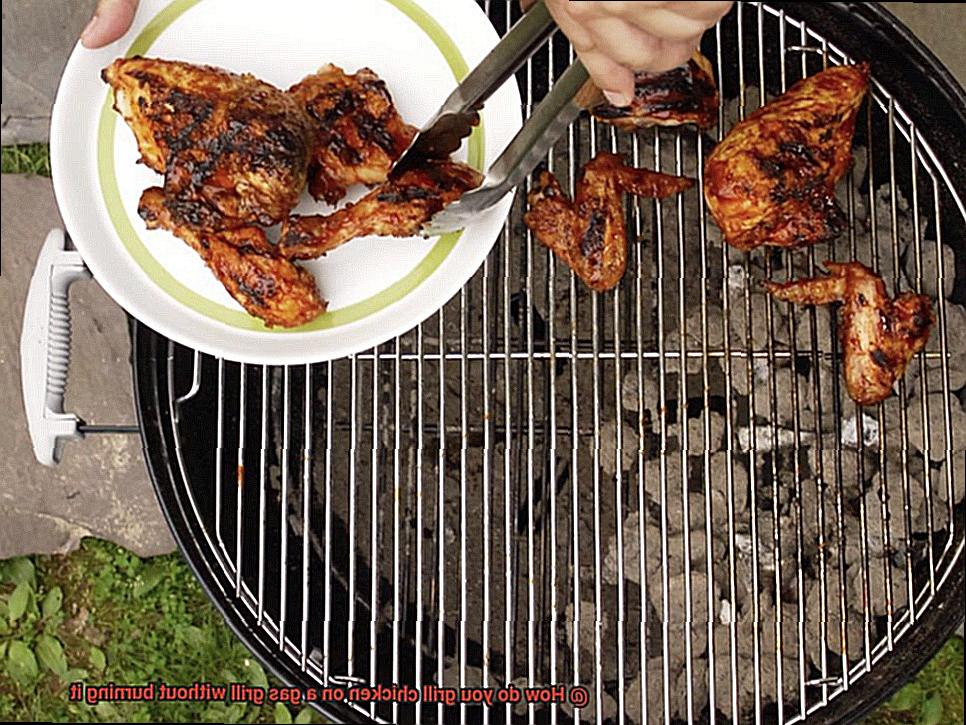
Using a Meat Thermometer to Check Doneness
Grilling chicken can be a tricky task, especially when it comes to determining whether it’s fully cooked or not. Many people tend to rely on visual cues such as the color of the meat or the juices running clear, but these may not always be reliable indicators of doneness. That’s where a meat thermometer comes in as a crucial tool in ensuring your chicken is cooked perfectly without burning it.
To use a meat thermometer, start by inserting it into the thickest part of the chicken, making sure not to touch any bones. The safe internal temperature for fully cooked chicken is 165°F (74°C). However, different parts of the chicken may cook at different rates, so it’s essential to take the temperature in multiple places. Chicken breasts, for example, may cook faster than chicken thighs or drumsticks.
Investing in a good quality meat thermometer is also crucial for accurate results. There are many types of meat thermometers available on the market, including digital and analog versions. Digital thermometers are often easier to read and provide quicker results. On the other hand, analog thermometers require more time to read and may be less accurate.
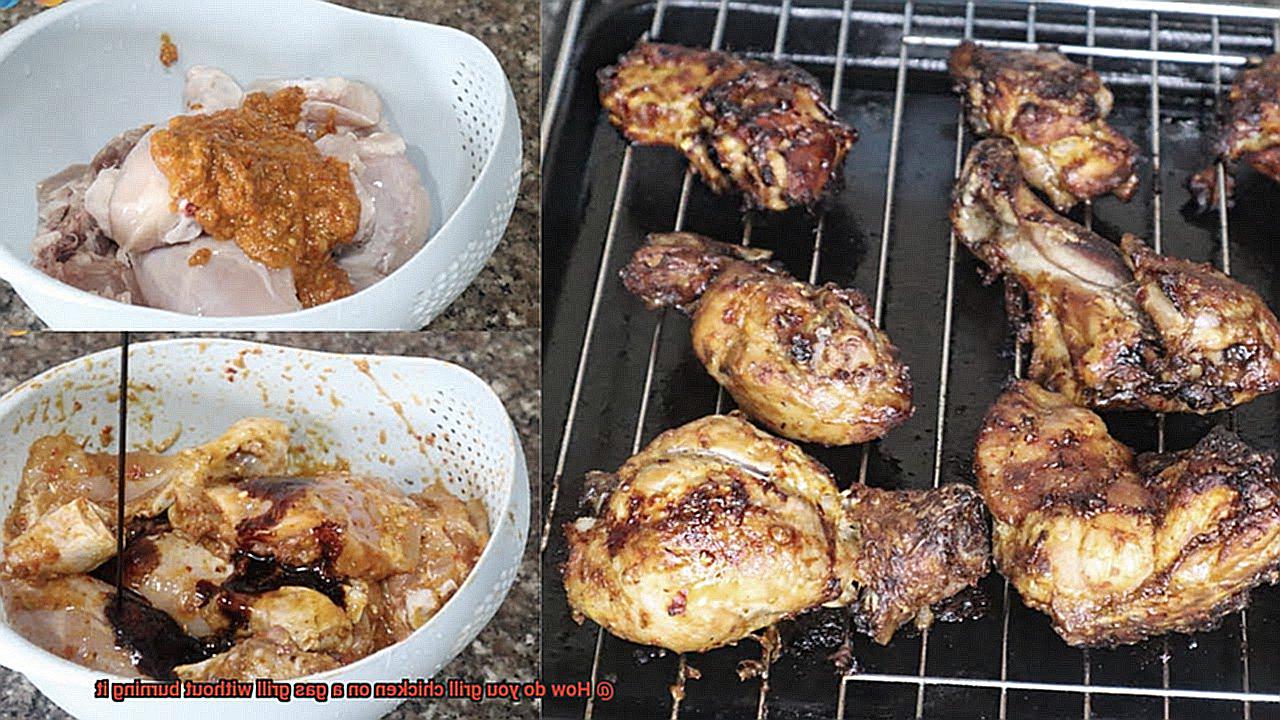
Don’t forget that using a meat thermometer not only ensures your chicken is safe to eat but also prevents overcooking or undercooking. This means you can enjoy juicy and flavorful chicken every time. So, remember to take the temperature in multiple places and invest in a good quality digital meat thermometer for the best results.
Tips for Perfectly Grilled Chicken Every Time
Grilling chicken on a gas grill can be a daunting task, but with the right techniques, you’ll achieve perfectly grilled and juicy chicken every time. Here are five tips to help you master grilling chicken on a gas grill.
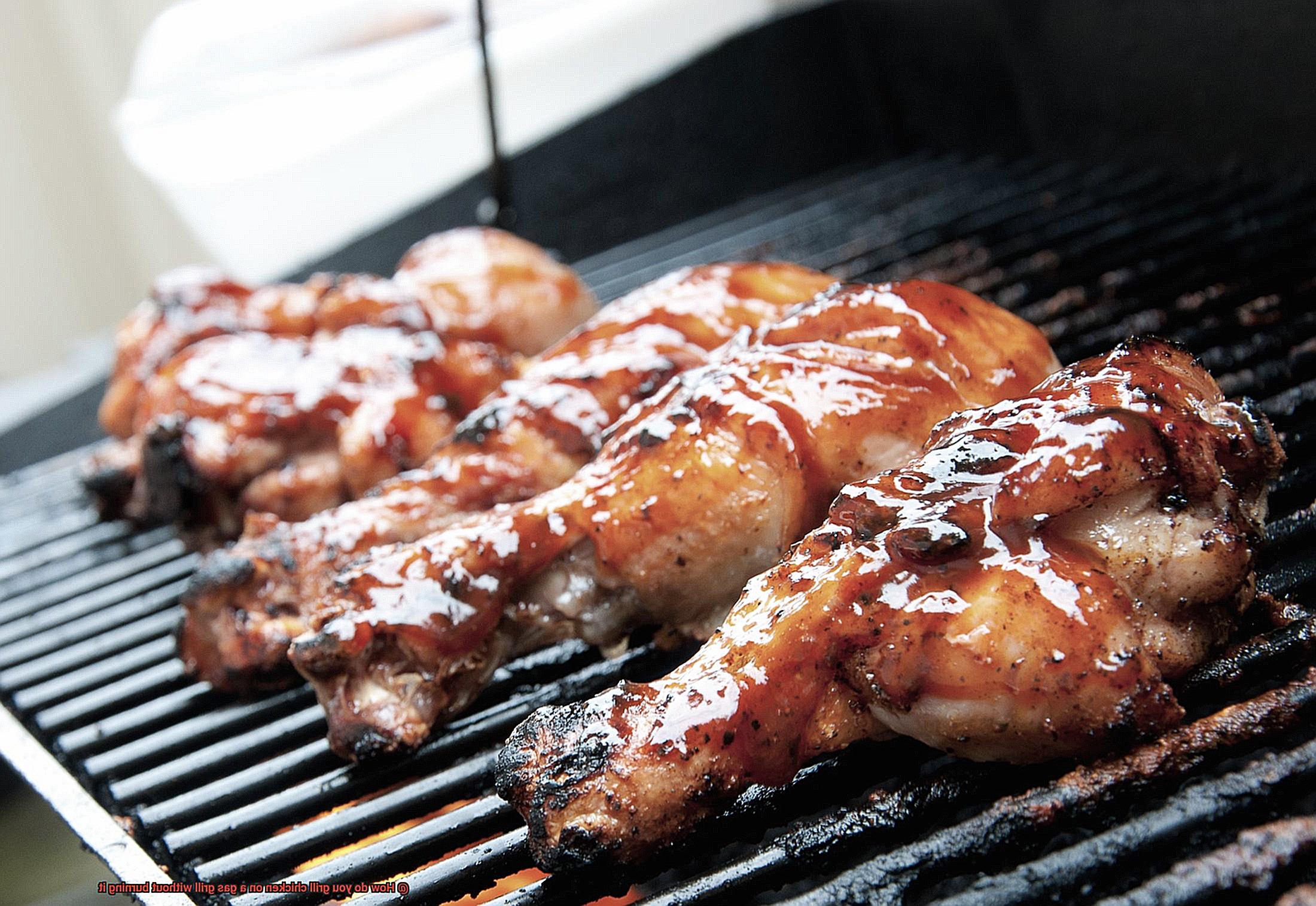
Preheat Your Grill
The first step to perfect grilled chicken is preheating your grill. This process helps distribute the heat evenly across the grates, preventing hot spots and ensuring your chicken cooks evenly. Allow your grill to heat up for 10-15 minutes before placing your chicken on the grates.
Season Your Chicken
Seasoning your chicken is an essential step in achieving delicious and flavorful grilled chicken. You can use dry rubs or marinades to add flavor and keep the chicken moist and tender.
Skin-Side Up
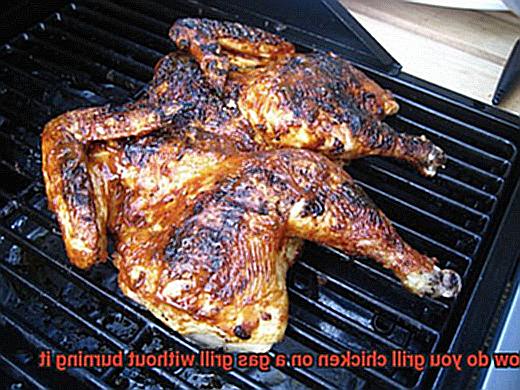
When placing your chicken on the grill, start with the skin-side up. This method helps to protect the meat from direct heat and prevent burning. Once the skin is crispy and browned, you can flip it over to cook the other side.
Monitor Grill Temperature
It’s crucial to keep an eye on the temperature of your grill while cooking. The ideal temperature for grilling chicken is between 350-400°F. If it’s too high, adjust by turning down one or more burners or raising the grill grates.
Use a Meat Thermometer
To ensure that your chicken is cooked thoroughly, use a meat thermometer to check the internal temperature of the meat. The chicken should reach an internal temperature of 165°F before removing it from the grill.
Lastly, allow your chicken to rest for a few minutes before slicing or serving. This allows for juices to redistribute throughout the meat, resulting in tender and juicy chicken.
y-ruEotdSTY” >
Also Read: Gas Grill Gets Too Hot on Low Setting
Conclusion
In conclusion, grilling chicken on a gas grill without burning it requires a bit of finesse and attention to detail. But fear not, with the right techniques, you can achieve succulent and flavorful chicken every time.
It all starts with selecting the perfect cut of chicken – bone-in and skin-on thighs or drumsticks are ideal for retaining moisture and flavor. And don’t forget to preheat your grill. This step is crucial for even cooking and avoiding burnt spots.
To elevate your grilled chicken game, seasoning is key. Properly seasoning your chicken before grilling adds depth of flavor and keeps the meat moist and tender. And when it’s time to hit the grill, placing the chicken skin-side up first helps protect it from direct heat and prevents burning.
While cooking, keep an eye on your grill’s temperature to ensure that your chicken cooks evenly without drying out or burning. A meat thermometer is also highly recommended to check the internal temperature of your chicken and prevent overcooking or undercooking.
And last but not least, give your grilled chicken some rest time. Allowing it to rest for a few minutes before slicing or serving ensures that juices redistribute throughout the meat, resulting in tender and juicy chicken.
With these tips and tricks up your sleeve, you’ll be a grilling pro in no time – impressing your guests with perfectly grilled chicken without any burnt mishaps.

